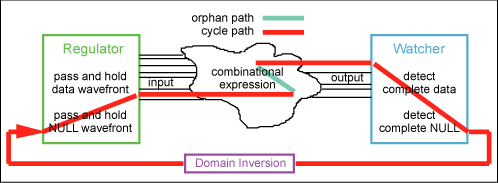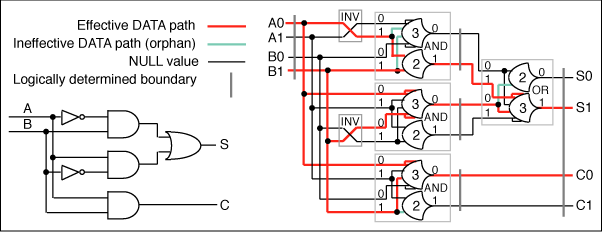The
2NCL Orphan Path
While
the behavior of variables at the boundaries of
an expression unit are logically determined, there
are individual signal paths inside the expression
unit that are not logically determined. For each
data wavefront through an expression unit there
will be an effective transition path which is
a logically determined irredundant path from the
input through the expression unit that generates
the output. When the output transitions to complete
DATA it implies that the input data set is complete
and that the transitions to DATA have propagated
over the effective path to the output. There will
also be ineffective paths branching off this effective
path that do not contribute to the output and
therefore are not logically determined by the
output. These ineffective paths will be called
orphans because they have lost all of their logical
relations. Figure 16 shows
the effective path and orphan paths for all four
data configurations of the XOR expression unit.
Figure
16. Effective paths and orphan paths through the
XOR gate equivalent expression.

A
slow orphan path is not a problem for an individual
data wavefront because the orphan paths do not
contribute to the output nor can they confuse
the generation of the output. The difficulty arises
with the possibility of a slow orphan getting
mixed up with a succeeding data wavefront.
Upon
completion of the data wavefront at the output,
the NULL wavefront will be requested and presented
to the input of the expression while orphans may
still be transitioning to DATA. The output of
the expression transitioning to all NULL implies
that the input and the entire effective path has
transitioned to NULL but it does not imply that
the orphans have transitioned to NULL. The next
DATA wavefront is requested and if all the orphan
paths from the previous data wavefront have not
transitioned to NULL, the next data wavefront
can interact with the slow orphan in a non logically
determined way. Ambiguous resolution, hazards,
glitches and chaos can ensue.
The
succeeding wavefront will arrive in one cycle
period of the expression. So the complete characterization
of the behavior of a 2NCL expression must include
the timing relationship that all orphan paths
must completely transition strictly faster than
the cycle period of the expression. Figure
17 shows an orphan path in relation to the
full cycle path of an expression.
Figure
17. The orphan path in relation to the cycle path.

Logical
Isolation of Orphans
Orphan
paths do not cross logically determined completeness
boundaries. If they did, the boundaries would
not be logically determined. Orphans are isolated
between the logically determined completeness
boundaries of expression units. Figure
18 provides an example of a 2NCL expression
generated from a Boolean logic expression by direct
gate substitution. Each gate equivalent expression
unit was logically determined at its boundaries
and those boundaries become internal to the greater
combinational expression. The effective path for
A = 0 and B = 1 is shown with the associated orphan
paths. It can be seen that all orphan paths are
isolated between the logically determined completeness
boundaries of each expression unit.
Figure
18. 2NCL expression by direct gate substitution
of a Boolean circuit.

It
is possible for an orphan path to include gates
and to be arbitrarily long but an orphan path
can always be limited to a local signal path by
making the portion of the orphan path which includes
gates an output variable subject to completion
determination. The part of the path including
the gate then becomes an effective data path that
is logically determined by the output thus shortening
the orphan path to a local signal path that does
not include a gate. The left expression of Figure
19 shows a 2NCL expression with an orphan
path that includes a gate. The right expression
of Figure 19 shows a new
logically determined boundary created by including
part of the orphan path in the completion determination
of the output.
Figure
19. Orphan path through gate limited to local
path with a created output variable.

The
orphan paths are the only logical ambiguity (delay
sensitivity) associated with 2NCL and they can
be limited to local signal paths isolated inside
expression units and their delay behavior can
be made insignificant in relation to the cycle
time of the expression.
|